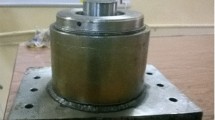Abstract
Recently, the concept of hard turning has gained considerable attention in metal cutting as it can apparently replace the traditional process cycle of turning, heat treating, and finish grinding for assembly of hard wear resistant steel parts. The present investigation aims at developing a magneto rheological (MR) fluid damper for suppressing tool vibration and promoting better cutting performance during hard turning. The magneto rheological Fluid acts as a viscoelastic spring with non-linear vibration characteristics that are controlled by the composition of the magneto rheological fluid, the shape of the plunger and the electric parameters of the magnetizing field. Cutting experiments were conducted to arrive at a set of electrical, compositional and shape parameters that can suppress tool vibration and promote better cutting performance during turning of AISI 4340 steel of 46 HRC with minimal fluid application using hard metal insert with sculptured rake face. It was observed that the use of MR fluid damper reduces tool vibration and improves the cutting performance effectively. Also commercialization of this idea holds promise to the metal cutting industry.
Similar content being viewed by others
References
Byrne G, Dornfeld D, Denkena B. Advancing cutting technology. CIRP Annals—Manufacturing Technology, 2003, 52(2): 483–507
Alexender R, Varadarajan A S, Philip P K. Hard turning with minimum cutting fluid—A viable green alternative on the shop floor. In: Proceedings of the 18th AIMTDR Conference, India, 1998, 183–187
Sam Paul P, Varadarajan A S. A multi-sensor fusion model based on artificial neural network to predict tool wear during hard turning. In: Proceedings of the Institution of Mechanical Engineers, Part B: Journal of Engineering Manufacture, 2012, 226(5): 853–860
Ghani A K, Choudhury I A, Husni. Husni. Study of tool life, surface roughness and vibration in machining nodular cast iron with ceramic tool. Journal of Materials Processing Technology, 2002, 127(1): 17–22
Arizmendi M, Campa F J, Fernández J, Lópes de Lacalle L N, Gil A, Bilbao E, Veiga F, Lamikiz A. Model for surface topography prediction in peripheral milling considering tool vibration. CIRP Annals-Manufacturing Technology, 2009, 58(1): 93–96
Altintas Y. Manufacturing Automation: Metal Cutting Mechanics, Machine Tool Vibrations and CNC Design. 1st ed. UK: Cambridge University Press, 2000
Spencer J B F, Dyke S J, Sain M K, Carlson J D. Phenomenological model of a magnetorheological damper. Journal of Engineering Mechanics, 1997, 123(2): 230–238
Torsten B, von Stryk O. Modelling and simulation of rheological fluid devices, http://citeseerx.ist.psu.edu/viewdoc/summary?doi=10.1.1.59.667
Wang M, Fei R Y. Chatter suppression based on nonlinear vibration characteristic of electrorheological fluids. International Journal of Machine Tools & Manufacture, 1999, 39(12): 1925–1934
Carlson J D, Sproston J L. Controllable fluids in 2000-Status of ER and MR fluid technology. In: Proceedings of 7th International Conference on New Actuator, Bermen, 2000, 126–130
Lord Corporation, http://mutualhosting.com/~lordfulfillment/upload/PB7138.pdf
Genc S, Phule P P. Rheological properties of magnetorheological fluids. Smart Materials and Structures, 2002, 11(1): 140–146
Mei D Q, Kong T R, Albert J S, Chen Z C. Magnetorheological fluid-controlled boring bar for chatter suppression. Journal of Materials Processing Technolology, 2009, 209(4): 1861–1870
Sathianarayanan D, Karunamoorthy L, Srinivasan J, Kandasami G S, Palanikumar K. Chatter suppression in boring operation using magnetorheological fluid damper. Materials and Manufacturing Processes, 2008, 23(4): 329–335
Ginder J M, Davis L C, Elie L D. Rheology of magnetorheological fluids: models and measurements. International Journal of Modern Physics B, 1996, 10(23,24): 3293–3303
Schwartz M M. Encyclopedia of Smart Materials. New York: John Wiley & Sons, 2002
Author information
Authors and Affiliations
Corresponding author
Rights and permissions
About this article
Cite this article
Paul, P.S., Varadarajan, A.S. Effect of magneto rheological damper on tool vibration during hard turning. Front. Mech. Eng. 7, 410–416 (2012). https://doi.org/10.1007/s11465-012-0341-4
Received:
Accepted:
Published:
Issue Date:
DOI: https://doi.org/10.1007/s11465-012-0341-4




